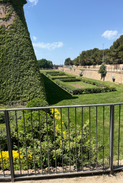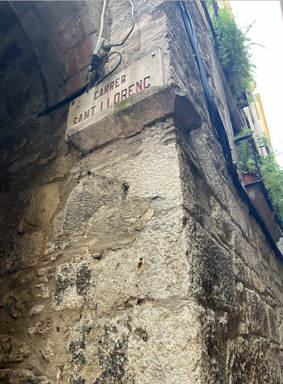Physical and Missing Spaces
It is best to start with what lies at the surface
This section will be dedicated to exploring the physical remains and often unacknowledged remnants of memory untouched by Jewish institutions or museums that are mostly unseen by the general public. In my time in Barcelona and Girona, I became aware of many small remains - the shallow engravings in stone where a mezuzah would have been, Jewish tombstones among the walls of cities, historic cemeteries among a public park - that are walked by and overlooked every day without second thought. These remains and spaces are acknowledged by a small minority of actors in memory work, like Dominique Tomasov Blinder at Urban Cultours. Below you can learn more about the remains of Jewish memory which are often hidden despite their positioning at the very surface of their respective cities.
Below is an interactive map with key locations, as they stand today, that are mentioned on this site.
Call-barcelona
The following pictures display the historical Call Major and Call Menor of Barcelona as they stand today. Throughout some of its streets one will notice copper plaques from the MUHBA El Call outlining some brief historical facts about the street or historical home but often times, there are stories that remain unacknowledged at the surface.
Please enjoy the following pictures relevant to my visit at Montjuic



photo info
Signage at 1 Carrer de Marlet
Carrer de Marlet-barcelona
The signage at the corner of Carrer de Marlet is an interesting example of Jewish memory work in Barcelona. My attention was drawn to this three-fold plaque from reading Dr. Tabea Alexa Linhard's book Jewish Spain: A Mediterranean Memory. She begins the book with an explanation of the plaques and their role in being examples of the "multidirectional memory"of Jewish Spain.
Starting from the top, we see a plaque in Hebrew reading (approximately) in English, "the pious Rabbi Samuel Ha-Sardi lived here, may his light burn forever." This plaque, however, is a replica of the real stone found on this building which is currently housing the Museu Historia de Barcelona (MUHBA).
The second plaque reads "El Santo Rabino Samuel Hasareri. Nunca se acabe su vida. Año 692. Se halló con otros restos del tiempo de los judíos en esta casa levantada sobre las ruinas de la que fundo Santo Domingo. Año 1820." which translates according to the Historical Marker Database to "The Holy Rabbi Samuel Hasareri - living eternally. Year 692. It (the stone) was found with other remains from the time that Jews were living in this house, and upon whose ruins Sant Domènec was founded and raised. Year 1820" (Historical Marker Database).
The third plaque is an explanatory plaque put up by MUHBA El Call which likewise provides a slightly different translation of the stone. All four plaques (if counting the original and replica of the first) are conducive to understanding how different the interpretations of the exact same site of memory can be traced back to the actors involved. The three plaques at 1 Carrer de Marlet are somewhat confusing to piece together as they each provide a different understanding of the man who is remembered within the Call. Dominique Tomasov Blinder likewise pointed out that we do not know who built this building or who put up the original stone honoring Rabbi Samuel Ha-Sardi. Dr. Linhard perfectly sums up these plaques by quoting James Young in The Texture of Memory who wrote that “Memory is never shaped in a vacuum; the motives of memory are never pure."
“Memory is never shaped in a vacuum; the motives of memory are never pure."
- James Young in The Texture of Memory



photo info
Ancient synagogue of Barcelona
ancient synagogue-barcelona
The ancient synagogue (Sinagoga Major) of Barcelona is housed at 5 Carrer de Marlet. It is believed to be one of the oldest synagogues in Europe. In 2002, the space was restored by Miguel Iaffa to a museum that was opened to the public. Unfortunately, the museum and synagogue are no longer in operation and all that remains today is the memory of Iaffa's restoration and graffitis on the door - one would never guess that an ancient holy place stood beyond such a defaced door.
When researching about the synagogue, I stumbled upon the site for the restored synagogue's museum and Associo Call de Barcelona which you can access here. As one can tell, the site has been overrun much like the doors to the synagogue - filled with nonsense about the FC Barcelona Soccer Team, sample web pages that have yet to be filled, and content in Vietnamese.
The remains of such a deeply important site and piece of history, although physically there, are overlooked by the many tourists who pass by this dilapidating door - creating but a blurred memory of the sanctity that once held the Jewish Call together.
mezuzahs and tombstones-barcelona
Throughout the Call of Barcelona and certainly in Girona as well are the shallow engravings in stone left in the position of what would have been a Mezuzah. The traditional scroll, placed within a casing on the doors of a home, denote the threshold of a Jewish home but are likewise placed at the entrance of rooms. The demarcations within the stone that are seen throughout the Call certainly indicate the streets' Jewish past. Within the realm of memory, these mezuzahs (without the proper context or explanation) give the unfortunate and unrealistic perception of Jewishness as an archaeological artifact rather than a living culture and religion. Without the scrolls' presence, the marks within the stone are devoid of living Jewishness and become markers of crystallized history. They are the haunting reminder of a community that no longer exists in this neighborhood.
In the below gallery, are pictures of tombstones from Montjuic (see above) that can be found in the walls a little outside the Cathedral of Barcelona. Some are flipped upside down, or are hard to read, but play an integral role in the unacknowledged Jewish history of Barcelona. These were pointed out by Dominique Tomasov Blinder whose tour likewise contextualized the stones' history as well.



photo info
Shallow engraving for mezuzah in Jewish quarter
Please enjoy the following pictures relevant to Mezuzahs and Tombstones embedded throughout Barcelona
Call -Girona
Below are pictures of Call Major of Girona as it stands today.
cathedral artwork-girona
Among the Cathedral of Girona's expansive collection of paintings, sculptures, and tapestries lies its arguably most important piece, "The Tapestry of Creation." The tapestry is an expansive and detailed work of Romanesque art that depicts various biblical scenes (with some particular ones from Genesis) along with other Christian iconography. This artwork pertains to Jewish memory as it depicts a Jewish couple (denoted as such) in the bottom left of the tapestry and is a clear indication of Jewish people's presence and representation within Christian 11th century society in Girona. The couple has been used to create the logo to Girona's Jewish museum, which is worth mentioning as well. Certainly, it is a decision that emphasizes the image created (literally) by the Church rather than an image created and curated by the Jewish community, itself. To read more about my visit to the museum, please visit this page.



photo info
Tapestry of Creation, Cathedral of Girona




photo info
View of Montjuic Cemetery from other side of the city
montjuic-girona
Much like Montjuic in Barcelona, the "Mountain of the Jews" in Girona was chosen for its positioning on a slope, facing the East, and away from the Call's location. There is not much known about Girona's Montjuic but like Barcelona, its Jewish tombstones are found throughout the city including most recently in a barber shop near the Jewish quarter. From 1492 onward, ever since the land of the Jewish cemetery was given to a nobleman and the tombstones were sold for construction, the land of the Jewish cemetery was left undisturbed until the late 19th century when the construction of a new rail cut through a corner of the old Jewish cemetery. The construction caused the finding of 20 Jewish tombstones (which can be found in the Girona Jewish History Museum) and today, there remains very little indication that the Jewish cemetery ever existed in that location. The cemetery's site can be seen vaguely in the distance towards the left in the picture.




























































